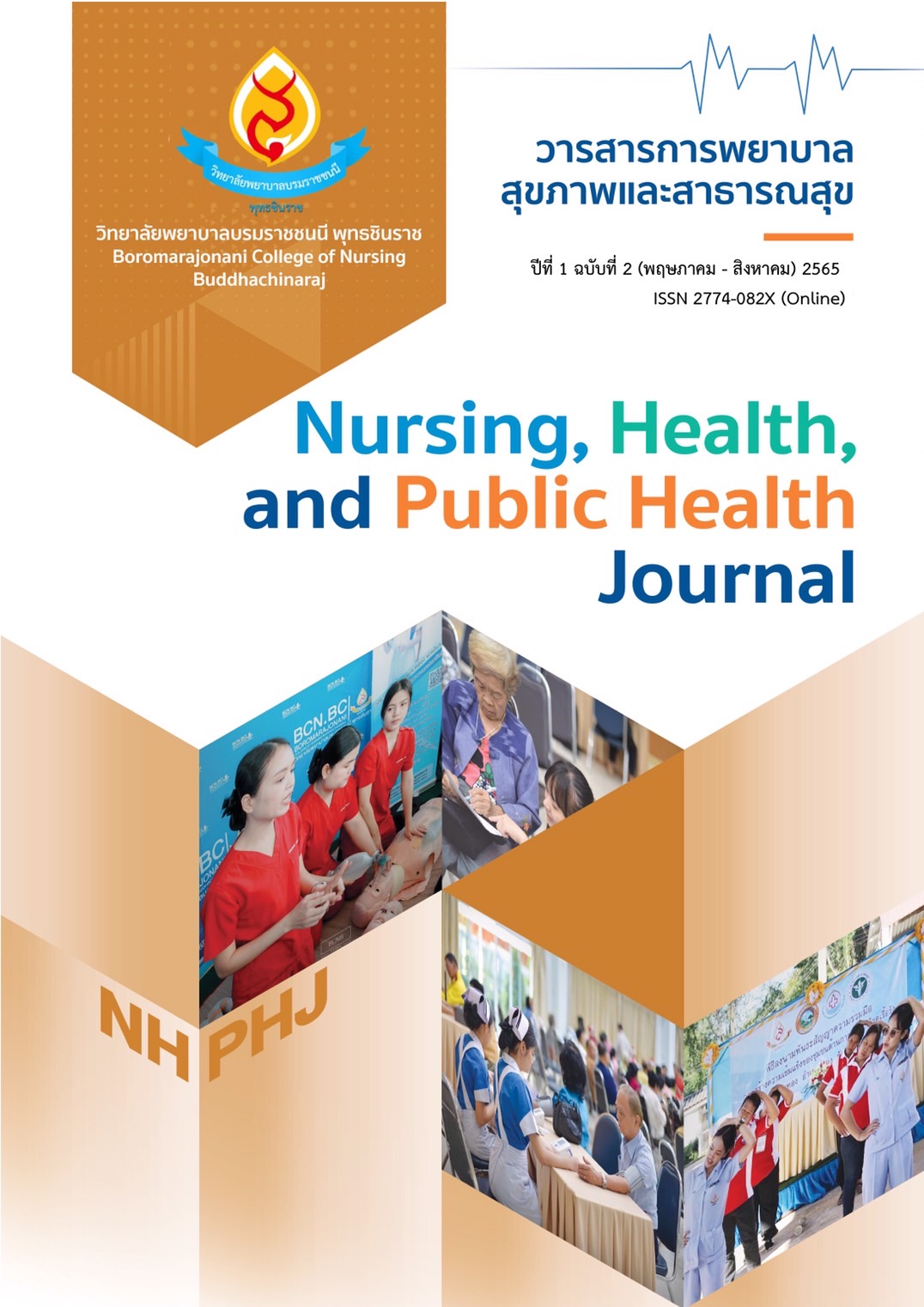การพยาบาลผู้ป่วยมะเร็งท่อน้ำดีที่ได้รับการใส่สายระบายน้ำดีและมีภาวะแทรกซ้อนสายระบายน้ำดีอุดตัน โรงพยาบาลพุทธชินราช พิษณุโลก: กรณีศึกษา
คำสำคัญ:
มะเร็งท่อน้ำดี , การใส่สายระบายน้ำดีผ่านทางผิวหนัง , ภาวะแทรกซ้อนบทคัดย่อ
ผู้ป่วยมะเร็งท่อน้ำดีที่ได้รับการใส่สายระบายน้ำดีกลับไปบ้านมีโอกาสเกิดภาวะแทรกซ้อนสายระบายน้ำดีอุดตันซึ่งนำไปสู่ภาวะอื่นได้ กรณีศึกษานี้มีวัตถุประสงค์เพื่อนำเสนอการพยาบาลผู้ป่วยมะเร็งท่อน้ำดีที่มีภาวะแทรกซ้อนสายระบายน้ำดีอุดตัน จำนวน 1 รายที่เข้ารับการรักษาที่โรงพยาบาลพุทธชินราช พิษณุโลก เก็บข้อมูลจากเวชระเบียน และการสัมภาษณ์ผู้ป่วย มีการกำหนดข้อวินิจฉัยการพยาบาลและวางแผนปฏิบัติการพยาบาลตามกระบวนการพยาบาล ผลการศึกษาพบว่า กรณีศึกษามีประวัติกลับมาใส่สายระบายน้ำดีซ้ำหลายครั้งจากภาวะสายระบายน้ำดีอุดตัน ผู้ป่วยมีความวิตกกังวลเกี่ยวกับการรักษาในระดับปานกลาง จากการเจ็บป่วยครั้งนี้ผู้ป่วยได้รับการรักษาโดยการเปลี่ยนสายระบายน้ำดี และได้รับการพยาบาลขณะมารับการรักษาในโรงพยาบาล โดยแบ่งออกเป็น 1) การพยาบาลเพื่อป้องกันภาวะแทรกซ้อนขณะอยู่โรงพยาบาล แบ่งออกเป็น 3 ระยะ คือ ระยะก่อนทำหัตถการ ขณะทำหัตถการ และระยะหลังทำหัตถการ และ 2) การพยาบาลเพื่อป้องกันภาวะแทรกซ้อนเมื่อกลับไปอยู่ที่บ้าน และแพทย์ได้อนุญาตให้กลับบ้านได้หลังจากเปลี่ยนสายระบายน้ำดีใหม่และผู้ป่วยมีอาการคงที่ คำแนะนำก่อนกลับบ้านประกอบด้วยโดยแนะนำการรับประทานยาอย่างต่อเนื่อง การสังเกตอาการไข้ การดูแลสายระบายน้ำดีและแผล การปฏิบัติตัวเมื่อมีอาการผิดปกติหรืออาการแสดงที่ต้องมาพบแพทย์ก่อนนัด การมาตรวจตามนัด และการส่งเสริมให้มีภาวะโภชนาการที่เหมาะสมเมื่อผู้ป่วยกลับบ้าน
เอกสารอ้างอิง
Acquisto, S., Iyer, R., Rosati, L. M., Pinheirn, N., Driskill, K., Musto, K., Lowitzer, H., Bradley, E. H., Drapek, L. (2018). Cholangiocarcinoma: Treatment, outcomes, and nutrition overview for oncology nurses. Clinical Journal of Oncology Nursing, 22(4). e97-e102. doi: 10.1188/18.CJON.E97-E102
Banales, J. M., Cardinale, V., Carpino, G., Marzioni, M., Andersen, J. B., Invernizzi, P., Lind, G. E., Folseraas, T., Forbes, S. J., Fouassier, L., Geier, A., Calvisi, D. F., Mertens, J. C., Trauner, M., Benedetti, A., Maroni, L., Vaquero, J., Macias, R. I. R., Raggi, C., Perugorria, M. J., Gaudio, E., Boberg, K. M., Marin, J. J. G., and Alvaro, D. (2016). Cholangiocarcinoma: Current knowledge and future perspectives consensus statement from the European Network for the Study of Cholangiocarcinoma (ENS-CCA). Nature Reviews Gastroenterology & Hepatology, 13(5), 261-280. doi:10.1038/nrgastro.2016.51
Eamchunprathip, S., Tnaaarak, S., & Tepapal, T. (2017). Discharge planning for orthopedic patients. Nursing Journal of the Ministry of Public Health, 27, 9-18.
Inamdar, S., Slattery, E., Bhalla, R., Sejpal, D. V., & Trindade, A. J. (2016). Comparison of adverse events for endoscopic vs percutaneous biliary drainage in the treatment of malignant biliary tract obstruction in an inpatient national cohort. JAMA Oncology, 2(1), 112-117. doi:10.1001/jamaoncol.2015.3670
Kamsa-ard, S., Kamsa-ard, S., Luvira, V., Suwanrungruang, K., Vatanasapt, P., & Wiangnon, S. (2018). Risk factors for cholangiocarcinoma in Thailand: A systematic review and meta-analysis. Asian Pacific journal of cancer prevention: APJCP, 19(3), 605-614. doi:10.22034/APJCP.2018.19.3.605
Nennstiel, S., Weber, A., Frick, G., Haller, B., Meining, A., Schmid, R. M., & Neu, B. (2015). Drainage-related complications in percutaneous transhepatic biliary drainage: An analysis over 10 years. Journal of Clinical Gastroenterology, 49(9), 764-770. doi:10.1097/mcg.0000000000000275
Panuthai, S. (2014). Factors affecting readiness for hospital discharge among older persons. Nursing Journal, 41(4), 150-160.
Patel, N., & Benipal, B. (2019). Incidence of cholangiocarcinoma in the USA from 2001 to 2015: A US cancer statistics analysis of 50 states. Cureus, 11(1), e3962. doi:10.7759/cureus.3962
Phujomjit, W. (2021). The holistic nursing care for high risk cholangiocarcinoma patients : Case study 2 case. Journal of Health and Environmental Eucation, 6(3), 35-42.
Rafiq, S., Khan, A., Suhail, J., Choh, N., & Shaheen, F. (2019). Complications of left and right sided percutaneous transhepatic biliary drainage. International Journal of Advances in Medicine, 6(4). doi:10.18203/2349-3933.ijam20193286
Rattanakanlaya, K., Vuttanon, N., Noppakun, L., Sangwattanarat, W., & Boonyu, N. (2021). Hospital discharge needs: Perspectives of patients with liver and bile duct cancer undergoing invasive percutaneous transhepatic biliary drainage and family caregivers. Nursing Journal, 48(3), 260-273.
Riauka, R., Ignatavičius, P., & Barauskas, G. (2018). Percutaneous transhepatic biliary drainage–the first step in the treatment of malignant biliary obstruction. Sveikatos, 28(4), 33.
Sarwar, A., Christopher, A. Hostage, J., Weinstein, J. L., Kim, G., Novack, V., Chakrala, N., Park, Y., Brook, O. R., Ahmed, M. (2019). Causes and rates of 30-day readmissions after percutaneous transhepatic biliary drainage procedure. Radiology, 290(3), 722-729. doi:10.1148/radiol.2018180279
Treeprasertsuk, S., Poovorawan, K., Soonthornworasiri, N., Chaiteerakij, R., Thanapirom, K., Mairiang, P., Sawadpanich, K., Sonsiri, K., Mahachai, V., Phaosawasdi, K. (2017). A significant cancer burden and high mortality of intrahepatic cholangiocarcinoma in Thailand: A nationwide database study. BMC Gastroenterology, 17(1), 3. doi:10.1186/s12876-016-0565-6
Tuqan, W. e., Innabi, A., Alawneh, A., Farsakh, F. A., & Al-Khatib, M. (2017). Prediction of survival following percutaneous biliary drainage for malignant biliary obstruction. Journal of Translational Internal Medicine, 5(2), 127-131. doi:10.1515/jtim-2017-0014
Yao, K. J., Jabbour, S., Parekh, N., Lin, Y., & Moss, R. A. (2016). Increasing mortality in the United States from cholangiocarcinoma: An analysis of the National Center for Health Statistics Database. BMC Gastroenterology, 16(1), 1-8. doi: 10.1186/s12876-016-0527-z
ดาวน์โหลด
เผยแพร่แล้ว
รูปแบบการอ้างอิง
ฉบับ
ประเภทบทความ
สัญญาอนุญาต
ลิขสิทธิ์ (c) 2022 วิทยาลัยพยาบาลบรมราชชนนี พุทธชินราช

อนุญาตภายใต้เงื่อนไข Creative Commons Attribution-NonCommercial-NoDerivatives 4.0 International License.



